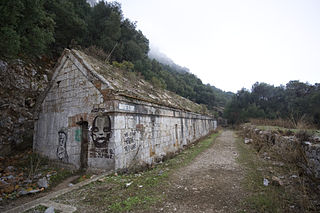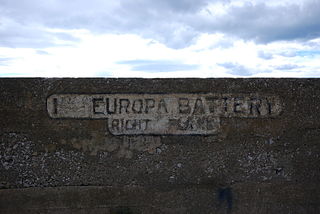
Breakneck Battery is an artillery battery in the British Overseas Territory of Gibraltar. It is located on Ministry of Defence property at the Upper Rock Nature Reserve, north of Lord Airey's Battery. It is one of a dozen batteries in Gibraltar that had 9.2-inch (233.7 mm) guns installed around the turn of the twentieth century. The emplacement features a 9.2-inch Mark X breech-loading gun on a Mark V mounting. The battery was refurbished by 10 Signal Regiment in 2012 and 2016 whilst being on Ceremonial duties whilst the Gibraltar Regiment where on exercise and is one of three surviving 9.2-inch gun emplacements at the Upper Ridge of the Rock of Gibraltar. By the late twentieth century, the 9.2-inch guns in Gibraltar, Bermuda, Portugal, South Africa, and Australia were the remaining examples of an emplacement that at one point had been mounted at strategic locations across the British Empire.

Wellington Front is a fortification in the British Overseas Territory of Gibraltar. It was built in 1840 on a site established by the Spanish in 1618.

Bomb Proof Battery was an artillery battery near Bomb Proof Barracks in the British Overseas Territory of Gibraltar. The battery was located at the south end of the King's Lines on the north-west face of the Rock of Gibraltar. It comprised a casemated battery built on two levels, each of which had two embrasures built into the old Spanish defences constructed above the then Puerta de Villavieja some time in the 16th century. The battery was partly built over when the King's Lines Battery was constructed.

The Europa Batteries are a group of artillery batteries in the British Overseas Territory of Gibraltar. Facing the North African coast, they are the most southerly batteries in Gibraltar and were built to cover ships approaching from the Mediterranean Sea. They run along the fortified clifftops of Europa Point from Camp Bay on the west side of the Rock of Gibraltar to the Europa Advance Batteries on the east side.
Victoria Battery was an artillery battery in the British Overseas Territory of Gibraltar. It was notable for being one of the two batteries in Gibraltar to mount a 100-ton gun.
West Battery is an artillery battery in the British Overseas Territory of Gibraltar. It is situated on the escarpment of Windmill Hill in the south of the territory.

Governor's Lookout Battery is one of the many artillery batteries in the British Overseas Territory of Gibraltar, which served to protect it against its many sieges. It is located off Signal Station Road within the Upper Rock Nature Reserve.

White Rock Battery was an artillery battery in the British Overseas Territory of Gibraltar. It was located at the northern end of Catalan Bay at the point where the road down to the village meets the main road.

Alexandra Battery is a coastal artillery battery in the British Overseas Territory of Gibraltar. It was constructed at the neck of the South Mole to enfilade the coastal fortifications of Gibraltar. The battery stood on the site of several previous fortifications; it was built over the New Mole Battery, which was itself constructed on the site of an old Spanish fort in front of the Tuerto Tower.
Upper Battery is a former artillery battery in the British Overseas Territory of Gibraltar. It was located on the Upper Ridge of the Rock of Gibraltar at a site south of Signal Hill Battery and faced east over the Mediterranean. It mounted two 32-pdrs. in 1861. On the other side of the hill, three 24-pdrs. were mounted at Lower Battery. The two batteries were used for signalling and drill purposes.
Willis' Battery is a former artillery battery on the north side of the British Overseas Territory of Gibraltar. It overlooks the isthmus between Spain and Gibraltar.
Woodford's Battery was an artillery battery in the British Overseas Territory of Gibraltar. It is located at Europa Flats between the Defensible Barracks and the Officer's Barracks and Eliott's Battery.
The Prince of Wales Batteries were a group of artillery batteries built in Gibraltar between 1859–60 and named after Albert Edward, Prince of Wales, who laid the batteries' foundation stone on 13 May 1859. They stood on the West Side of Gibraltar, facing the sea, and were constructed on top of the former Prince Henry's Battery, built during the Anglo-Spanish War of 1762–3. The batteries were originally intended to mount four 32-pdr guns but they were extended to mount eleven guns in four groups. They were rebuilt again around 1872 when two new gun emplacements were built on top of Nos. 2 and 3 batteries to accommodate two 9-inch rifled muzzle loader guns.
Prince Henry's Battery was an artillery battery built in Gibraltar during the Anglo-Spanish War of 1762–63, adjoining the Prince of Wales Lines. They mounted three 32-pdr guns with two more 18-pdrs, six 12-pdrs and three 4-pdrs on the Lines. After 1841, the battery was rebuilt as a retired battery as part of a mid-19th century remodelling of Gibraltar's southern defences. They were eventually built over in 1859–60 when the Prince of Wales Batteries were constructed on the same site.
Princess Charlotte's Battery was an artillery battery built in Gibraltar during the 18th century. It was constructed in the Willis's Plateau area on the upper northern slopes of the Rock of Gibraltar. Formerly called Catalan Battery, it was renamed after Sophia Charlotte of Hanover, the wife of King Frederick I of Prussia, who was the brother of King George I of Great Britain. The battery saw service in the Thirteenth Siege of Gibraltar in 1727 and inflicted substantial damage on the attacking Spanish forces. By 1773 it had two 12-pdr guns. Its armament was upgraded to four 24-pdrs in 1834, and from 1885 to 1889 it mounted two 64-pdr rifled muzzle loaders.
The Windmill Hill Batteries are a series of artillery batteries situated on Windmill Hill, Gibraltar near the south of the peninsula. They are part of the fortifications of Gibraltar. The batteries were originally established by Lt General Edward Cornwallis during his governorship of Gibraltar between 1762–77, built on the site of the old windmills after which the hill was named. The singular Windmill Hill Battery refers to one particular battery almost equidistant between Genista Battery and Europa Advance Battery.
The North Mole Elbow Battery was an artillery battery situated on Gibraltar's Old Mole, at the point where the mole turns north. It is recorded as mounting three 12-pdr guns in 1903. It mounted a Bofors 40 mm anti-aircraft gun during the Second World War along with a 6-pdr gun on a twin mounting for coastal defence purposes. At the end of the mole, another 6-pdr gun was installed on a twin mounting.
Mount Misery Battery was an artillery battery situated on the Upper Ridge of the Rock of Gibraltar. It was situated at Mount Misery, one of the peaks of the Rock. In 1901 its name was changed to Breakneck Battery at the suggestion of Major-General Sir John Slade of the Royal Artillery. Slade was to go on command British troops in Egypt from 1903 to 1905. Following his suggestion in 1899 that it would be a suitable position to accommodate a long-range coastal defence gun, a 9.2-inch breech-loading Mark X gun on a Mark V mounting was installed in 1906.

Prince Albert's Front is a curtain wall that formerly comprised part of the seafront fortifications of Gibraltar. It runs between the King's Bastion and Orange Bastion. The Front was constructed in 1842 after a report by Major General Sir John Thomas Jones recommended improving Gibraltar's seafront defences to guard against the threat of an amphibious assault. It was named after Prince Albert, Queen Victoria's prince consort. The Front straightened out the line of Gibraltar's coastal curtain wall; parts of the original curtain wall, some of which dates from the Moorish period over 500 years ago, can still be seen.

Victoria Battery was an artillery battery in the British Overseas Territory of Gibraltar. It was built in the 1840s on top of the earlier Princess of Wales Batteries following a report by Major-General Sir John Thomas Jones on Gibraltar's defences. The battery was located on the west side of Gibraltar and was one of a number of "retired" batteries in the territory, constructed to improve the coastal defences between Europa Point and the town.










